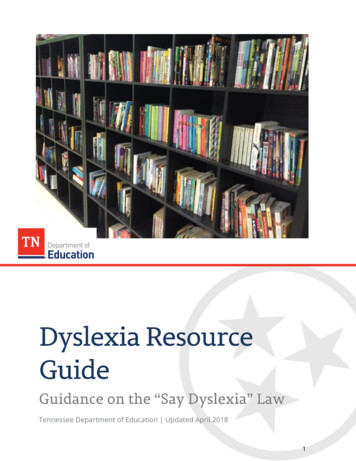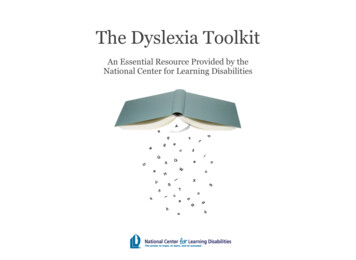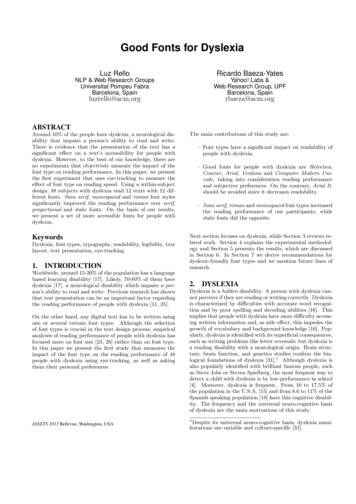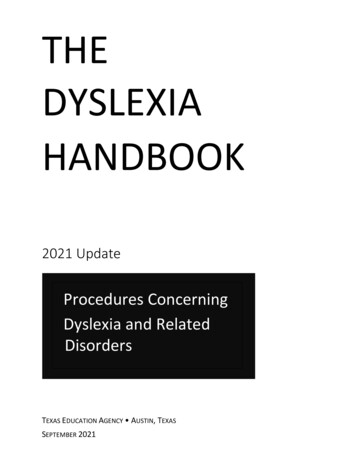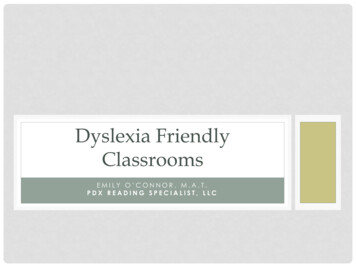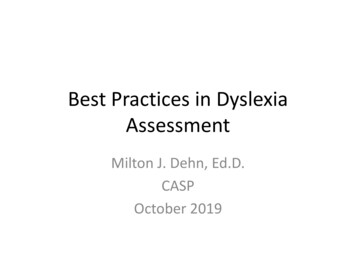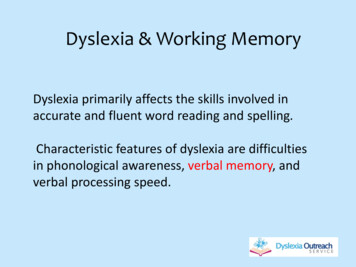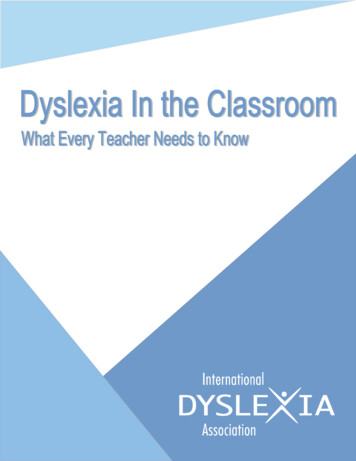
Transcription
TABLE OF CONTENTSIntroduction2About IDA2What is Dyslexia?3Signs and Symptoms of Dyslexia4Social and Emotional Connection5Classroom Strategies, Tips, and Tools7Multisensory Structured Language Teaching11Screening, Evaluation, and Diagnosis12Additional Resources and Further Reading14References15 Copyright 2017, International Dyslexia Association (IDA).IDA encourages the reproduction and distribution of this resource kit. If portions of the text are cited,appropriate reference must be made. This may not be reprinted for the purpose of resale.40 York Road, 4th Floor Baltimore, MD 21204Info@DyslexiaIDA.orgwww.DyslexiaIDA.org1
INTRODUCTIONThe degree of difficulty a child with dyslexia has with reading, spelling, and/or speaking varies from person to persondue to inherited differences in brain development, as well as the type of teaching the person receives. The brain isnormal, often very “intelligent,” but with strengths in areas other than the language area.This “difference” goes undetected until the person finds difficulty when learning to read and write. Each individual withdyslexia is unique, but the multisensory approach is flexible enough to serve a wide range of ages and learningdifferences. A multisensory approach can be valuable to many; to the dyslexic child it is essential. The expertise of theteacher is the key.The intent of this toolkit is to provide classroom teachers with basic information about dyslexia, dispel some of themyths and misconception surrounding it and be a resource that will increase their capacity to ensure the success of thediverse group of learners in their classrooms.ABOUT IDAThe International Dyslexia Association (IDA) was founded in 1949 as The Orton Society to honor and further the workand passion of Dr. Samuel Torrey Orton. IDA serves individuals with dyslexia, their families, and professionals in thefield. We have more than 9,000 members, 42 branches throughout the United States and Canada and have 27 globalpartners in 23 countries. Together we are working to help those with and affected by dyslexia.We believe that all individuals have the right to achieve their potential, that individual learning abilities can bestrengthened, and that social, educational and barriers to language acquisition and use must be removed.IDA actively promotes effective teaching approaches and related clinical educational intervention strategies forindividuals with dyslexia. We support and encourage interdisciplinary research. We facilitate the exploration of thecauses and early identification of dyslexia and are committed to the responsible and wide dissemination of researchand evidence based knowledge.The purpose of IDA is to pursue and provide the most comprehensive range of information and services that addressthe full scope of dyslexia and related difficulties in learning to read and write.in a way that creates hope, possibility,and partnership, so that every individual has the opportunity to lead a productive and fulfilling life, and society benefitsfrom the resource that is liberated.2
WHAT IS DYSLEXIA?The formal definition of dyslexia is:Dyslexia is a specific learning disability that is neurological in origin. It is characterized by difficulties withaccurate and/or fluent word recognition and by poor spelling and decoding abilities. These difficulties typicallyresult from a deficit in the phonological component of language that is often unexpected in relation to othercognitive abilities and the provision of effective classroom instruction. Secondary consequences may includeproblems in reading comprehension and reduced reading experience that can impede the growth of vocabularyand background knowledge.But what does that mean exactly?Dyslexia is a language-based learning disability. Dyslexia refers to a cluster of symptoms, which result in people havingdifficulties with specific language skills, particularly reading. Students with dyslexia usually experience difficulties withother language skills, such as spelling, writing, and pronouncing words. Dyslexia affects individuals throughout theirlives; however, its impact can change at different stages in a person’s life. It is referred to as a learning disabilitybecause dyslexia can make it very difficult for a student to succeed academically in the typical instructionalenvironment, and in its more severe forms, will qualify a student for special education, special accommodations, and/or extra support services.What causes dyslexia?The exact causes of dyslexia are still not completely clear, but anatomical and brain imagery studies show differences inthe way the brain of a person with dyslexia develops and functions. Moreover, most people with dyslexia have beenfound to have problems with identifying the separate speech sounds within a word and/or learning how lettersrepresent those sounds, a key factor in their reading difficulties. Dyslexia is not due to either lack of intelligence ordesire to learn; with appropriate teaching methods, students with dyslexia can learn successfully.Dyslexia occurs in people of all backgrounds and intellectual levels. People with dyslexia can be very bright. They areoften capable or even gifted in areas such as art, computer science, design, drama, electronics, math, mechanics,music, physics, sales, and sports. In addition, dyslexia runs in families; having a parent or sibling with dyslexia increasesthe probability that you will also have dyslexia. For some people, their dyslexia is identified early in their lives, but forothers, their dyslexia goes unidentified until they get older.What are the effects of dyslexia?The impact that dyslexia has is different for each person and depends on the severity of the condition and thetimeliness and effectiveness of instruction or remediation. The core difficulty involves word recognition and readingfluency, spelling, and writing. Some individuals with dyslexia manage to learn early reading and spelling tasks,especially with excellent instruction, but later experience their most debilitating problems when more complexlanguage skills are required, such as grammar, understanding textbook material, and writing essays.People with dyslexia can also have problems with spoken language, even after they have been exposed to excellentlanguage models in their homes and high quality language instruction in school. They may find it difficult to express3
themselves clearly, or to fully comprehend what others mean when they speak. Such language problems are oftendifficult to recognize, but they can lead to major problems in school, in the workplace, and in relating to other people.The effects of dyslexia reach well beyond the classroom.What misconceptions exist regarding dyslexia?It is equally important to understand what dyslexia isn’t. There are great misconceptions and myths about dyslexiawhich make it that much more difficult for someone with dyslexia to receive help and generally be understood.It is a myth that individuals with dyslexia “read backwards.” Their spelling can look quite jumbled at times not becausethey read or see words backwards, but because students have trouble remembering letter symbols for sounds andletter patterns in words.Dyslexia is not a disease and, therefore, there is no cure. With proper diagnosis, appropriate and timely instruction,hard work, and support from family, teachers, friends, and others, individuals who have dyslexia can succeed in schooland later as adults.Individuals with dyslexia do not have a lower level of intelligence. In fact, more often than not, the complete oppositeis true.SIGNS AND SYMPTOMS OF DYSLEXIAIt is crucial to be able to recognize the signs of symptoms of dyslexia. The earlier a child is evaluated, the sooner he orshe can obtain the appropriate instruction and accommodations he or she needs to succeed in school.General problems experienced by people with dyslexia include the following: Learning to speakLearning letters and their soundsOrganizing written and spoken languageMemorizing number factsReading quickly enough to comprehendKeeping up with and comprehending longer reading assignmentsSpellingLearning a foreign languageCorrectly doing math operationsSome specific signs for elementary aged children may include: 4Difficulty with remembering simple sequences such as counting to 20, naming the days of the week, orreciting the alphabetDifficulty understanding the rhyming of words, such as knowing that fat rhymes with catTrouble recognizing words that begin with the same sound (for example, that bird, baby”, and big all startwith b)Pronunciation difficulties
Trouble easily clapping hands to the rhythm of a songDifficulty with word retrieval (frequently uses words like “stuff” and “that thing” rather than specific wordsto name objects)Trouble remembering names of places and peopleDifficulty remembering spoken directionsIt is important to note that not all students who have difficulties with these skills have dyslexia. Formal testing ofreading, language, and writing skills is the only way to confirm a diagnosis of suspected dyslexia.An individual can have more than one learning or behavioral disability. For example, in various studies as many as 30%of those diagnosed with a learning or reading difference have also been diagnosed with ADHD. Although disabilitiesmay co-occur, one is not the cause of the other.SOCIAL AND EMOTIONAL CONNECTIONSamuel T. Orton, M.D., was one of the first researchers to describe the emotional aspects of dyslexia. According to hisresearch, the majority of preschoolers who were later diagnosed as having dyslexia are happy and well adjusted. Theiremotional problems begin to develop when early reading instruction does not match their learning needs. Over theyears, the frustration mounts as classmates surpass the student with dyslexia in reading skills.Stress and AnxietyJerome J. Schultz’s informative IDA fact sheet “The Dyslexia-Stress-Anxiety Connection” is a must read for thosewanting guidance on understanding the relationship between dyslexia and emotional and social difficulties, as well asthe implications for academic performance and social interactions. Dr. Schultz explains his DE-STRESS model in a stepby-step guide for addressing stress, anxiety, and dyslexia.Stress and anxiety increase when we’re in situations over which we have little or no control (e.g., a car going offthe road, tripping on the stairs, reading in public). All people, young and old, can experience overwhelmingstress and exhibit signs of anxiety, but children, adolescents, and adults with dyslexia are particularlyvulnerable. That’s because many individuals do not fully understand the nature of their learning disability, andas a result, tend to blame themselves for their own difficulties. Years of self-doubt and self-recrimination mayerode a person’s self-esteem, making them less able to tolerate the challenges of school, work, or socialinteractions and more stressed and anxious.Many individuals with dyslexia have experienced years of frustration and limited success, despite countlesshours spent in special programs or working with specialists. Their progress may have been agonizingly slow andfrustrating, rendering them emotionally fragile and vulnerable. Some have been subjected to excessivepressure to succeed (or excel) without the proper support or training. Others have been continuouslycompared to siblings, classmates, or co-workers, making them embarrassed, cautious, and defensive.Individuals with dyslexia may have learned that being in the company of others places them at risk for makingpublic mistakes and the inevitable negative reactions that may ensue. It makes sense, then, that many people5
with dyslexia have become withdrawn, sought the company of younger people, or become social isolates.(Schultz, 2013, p. 2)This fact sheet can be found on the IDA website, www.DyslexiaIDA.org.Self-ImageDyslexia can also affect a person’s self-image. Students with dyslexia often end up feeling “dumb” and less capablethan they actually are. After experiencing a great deal of stress due to academic problems, a student may becomediscouraged about continuing in school.If children succeed in school, they will develop positive feelings about themselves and believe that they can succeed inlife. If children meet failure and frustration, they learn that they are inferior to others, and that their effort makes verylittle difference. Instead of feeling powerful and productive, they learn that their environment controls them. They feelpowerless and incompetent.Researchers have learned that when typical learners succeed, they credit their own efforts for their success. When theyfail, they tell themselves to try harder. However, when learners with dyslexia succeed, they are likely to attribute theirsuccess to luck. When they fail, they simply see themselves as stupid.Research also suggests that these feelings of inferiority develop by the age of 10. After this age, it becomes extremelydifficult to help the child develop a positive self-image. This is a powerful argument for early intervention.DepressionDepression is also a frequent complication in dyslexia. Depressed children and adolescents often have differentsymptoms than do depressed adults. The depressed child is unlikely to be lethargic or to talk about feeling sad. Insteadhe or she may become more active or misbehave to cover up the painful feelings. In the case of masked depression,the child may not seem obviously unhappy. However, both children and adults who are depressed tend to have threesimilar characteristics: They tend to have negative thoughts about themselves, that is, a negative self- image.They tend to view the world negatively. They are less likely to enjoy the positive experiences in life. Thismakes it difficult for them to have fun.Most depressed youngsters have great trouble imagining anything positive about the future. Thedepressed child with dyslexia not only experiences great pain in his present experiences, but also foreseesa life of continuing failure.So how can you help?Children are more successful when early in their lives someone has been extremely supportive and encouraging, andwhen they have found an area in which they can succeed. Teachers can create an incredible support system by: 6Listening to children’s feelings. Anxiety, anger and depression can be daily companions for children withdyslexia. However, their language problems often make it difficult for them to express their feelings.Therefore, adults must help them learn to talk about their feelings.Rewarding effort, not just “the product.” For students with dyslexia, grades should be less important thanprogress.
When confronting unacceptable behavior, do not inadvertently discourage the child with dyslexia. Wordssuch as “lazy” or “incorrigible” can seriously damage the child’s self-image.Helping students set realistic goals for themselves. Many students with dyslexia set perfectionistic andunattainable goals. By helping the child set an attainable goal, teachers can change the cycle of failure.Above all, it is critical that school personnel, parents, and outside professionals working with the child with dyslexiacommunicate on an on-going basis to provide the support needed, so he or she can become a happy and successfulstudent, and eventually, a happy and successful adult.CLASSROOM STRATEGIES, TIPS AND TOOLSSchools can implement academic accommodations and modifications to help students with dyslexia succeed. Forexample, a student with dyslexia can be given extra time to complete tasks, help with taking notes, and workassignments that are modified appropriately. Teachers can give taped tests or allow students with dyslexia to usealternative means of assessment. Students can benefit from listening to books on tape and using text reading and wordprocessing computer programs.Teaching students with dyslexia across settings is challenging. Both general education and special education teachersseek accommodations that foster the learning and management of a class of heterogeneous learners. It is important toidentify accommodations that are reasonable to ask of teachers in all classroom settings. The followingaccommodations provide a framework for helping students with learning problems achieve in general education andspecial education classrooms. They are organized according to accommodations involving materials, interactiveinstruction, and student performance.Accommodations Involving MaterialsStudents spend a large portion of the school day interacting with materials. Most instructional materials give teachersfew activities or directions for teaching a large class of students who learn at different rates and in various ways. Thissection provides material accommodations that enhance the learning of diverse students. Frequently,paraprofessionals, volunteers, and students can help develop and implement various accommodations. Materialaccommodations include the following:7 Clarify or simplify written directions. Some directions are written in paragraph form and contain manyunits of information. These can be overwhelming to some students. The teacher can help by underlining orhighlighting the significant parts of the directions. Rewriting the directions is often helpful. Present a small amount of work. The teacher can tear pages from workbooks and materials to presentsmall assignments to students who are anxious about the amount of work to be done. This techniqueprevents students from examining an entire workbook, text, or material and becoming discouraged by theamount of work.
Block out extraneous stimuli. If a student is easily distracted by visual stimuli on a full worksheet or page,a blank sheet of paper can be used to cover sections of the page not being worked on at the time. Also,line markers can be used to aid reading, and windows can be used to display individual math problems.Additionally, using larger font sizes and increasing spacing can help separate sections. Highlight essential information. If an adolescent can read a regular textbook but has difficulty finding theessential information, the teacher can mark this information with a highlight pen. Use a placeholder in consumable material. In consumable materials in which students progresssequentially (such as workbooks), the student can make a diagonal cut across the lower right-hand cornerof the pages as they are completed. With all the completed pages cut, the student and teacher can readilylocate the next page that needs to be corrected or completed. Provide additional practice activities. Some materials do not provide enough practice activities forstudents with learning problems to acquire mastery on selected skills. Teachers then must supplement thematerial with practice activities. Recommended practice exercises include instructional games, peerteaching activities, self-correcting materials, computer software programs, and additional worksheets. Provide a glossary in content areas. Students often benefit from a glossary of content-related terms. Develop reading guides. A reading guide helps the reader understand the main ideas and sort out thenumerous details related to the main ideas. A reading guide can be developed paragraph-by-paragraph,page-by-page, or section-by-section. Use an audio recording device. Directions, stories, and specific lessons can be recorded. The student canreplay the tape to clarify understanding of directions or concepts. Also, to improve reading skills, thestudent can read the printed words silently as they are presented on tape. Use of assistive technology. Assistive technology products such as tablets, electronic readers/dictionaries/spellers, text to speech programs, audio books, and more can be very useful tools.Accommodations Involving Interactive InstructionThe task of gaining students’ attention and engaging them for a period of time requires many teaching and managingskills. Teaching and interactions should provide successful learning experiences for each student. Someaccommodations to enhance successful interactive instructional activities are:8 Use explicit teaching procedures. Many commercial materials do not cue teachers to use explicit teachingprocedures; thus, the teacher often must adapt a material to include these procedures. Teachers caninclude explicit teaching steps within their lessons (i.e., present an advanced organizer, demonstrate theskill, provide guided practice, offer corrective feedback, set up independent practice, monitor practice, andreview). Repeat directions. Students who have difficulty following directions are often helped by asking them torepeat the directions in their own words. The student can repeat the directions to a peer when the teacheris unavailable. If directions contain several steps, break down the directions into subsets. Simplifydirections by presenting only one portion at a time and by writing each portion on the chalkboard as well
as stating it orally. When using written directions, be sure that students are able to read and understandthe words as well as comprehend the meaning of sentences. Maintain daily routines. Many students with learning problems need the structure of daily routines toknow and do what is expected. Provide a copy of lesson notes. The teacher can give a copy of lesson notes to students who have difficultytaking notes during presentations. Provide students with a graphic organizer. An outline, chart, or blank web can be given to students to fillin during presentations. This helps students listen for key information and see the relationships amongconcepts and related information. Use step-by-step instruction. New or difficult information can be presented in small sequential steps. Thishelps learners with limited prior knowledge who need explicit or part-to-whole instruction. Simultaneously combine verbal and visual information. Verbal information can be provided with visualdisplays (e.g., on an overhead or handout). Write key points or words on the chalkboard/whiteboard. Prior to a presentation, the teacher can writenew vocabulary words and key points on the chalkboard/whiteboard. Use balanced presentations and activities. An effort should be made to balance oral presentations withvisual information and participatory activities. Also, there should be a balance between large group, smallgroup, and individual activities. Use mnemonic instruction. Mnemonic devices can be used to help students remember key information orsteps in a learning strategy. Emphasize daily review. Daily review of previous learning or lessons can help students connect newinformation with prior knowledge.Accommodations Involving Student PerformanceStudents vary significantly in their ability to respond in different modes. For example, students vary in their ability togive oral presentations; participate in discussions; write letters and numbers; write paragraphs; draw objects; spell;work in noisy or cluttered settings; and read, write, or speak at a fast pace. Moreover, students vary in their ability toprocess information presented in visual or auditory formats. The following accommodation involving mode ofreception and expression can be used to enhance students’ performance:9 Change response mode. For students who have difficulty with fine motor responses (such as handwriting),the response mode can be changed to underlining, selecting from multiple choices, sorting, or marking.Students with fine motor problems can be given extra space for writing answers on worksheets or can beallowed to respond on individual chalkboards/whiteboards. Provide an outline of the lesson. An outline enables some students to follow the lesson successfully andmake appropriate notes. Moreover, an outline helps students to see the organization of the material andask timely questions.
10 Encourage use of graphic organizers. A graphic organizer involves organizing material into a visual format.To develop a graphic organizer, the student can list the topic on the first line, collect and divide informationinto major headings, list all information relating to major headings on index cards, organize informationinto major areas, place information under appropriate subheadings, and place information into theorganizer format. Place students close to the teacher. Students with attention problems can be seated close to the teacher,chalkboard/whiteboard, or work area and away from distracting sounds, materials, or objects. Encourage use of assignment books or calendars. Students can use calendars to record assignment duedates, list school related activities, record test dates, and schedule timelines for schoolwork. Studentsshould set aside a special section in an assignment book or calendar for recording homework assignments. Have students turn lined paper vertically for math. Lined paper can be turned vertically to help studentskeep numbers in appropriate columns while computing math problems. Use cues to denote important items. Asterisks or bullets can denote questions or activities that countheavily in evaluation. This helps students spend time appropriately during tests or assignments. Design hierarchical worksheets. The teacher can design worksheets with problems arranged from easiestto hardest. Early success helps students begin to work. Allow use of instructional aids. Students can be provided with letter and number strips to help them writecorrectly. Number lines, counters, calculators, and other assistive technology can help students computeonce they understand the mathematical operations. Display work samples. Samples of completed assignments can be displayed to help students realizeexpectations and plan accordingly. Use peer-mediated learning. The teacher can pair peers of different ability levels to review their notes,study for a test, read aloud to each other, write stories, or conduct laboratory experiments. Also, a partnercan read math problems for students with reading problems to solve. Use flexible work times. Students who work slowly can be given additional time to complete writtenassignments. Provide additional practice. Students require different amounts of practice to master skills or content.Many students with learning problems need additional practice to learn at a fluency level. Use assignment substitutions or adjustments. Students can be allowed to complete projects instead oforal reports or vice versa. Also, tests can be given in oral or written format.
EFFECTIVE READING INSTRUCTIONEarly identification and treatment is the key to helping individuals with dyslexia achieve in school and in life. Mostpeople with dyslexia need help from a teacher, tutor, or therapist specially trained in a structured literacy approach.Many individuals with dyslexia need one-on-one help so that they can move forward at their own pace. In addition,students with dyslexia often need a great deal of structured practice and immediate, corrective feedback to developautomatic word recognition skills. For students with dyslexia, it is helpful if their outside academic therapists workclosely with classroom teachers.What is a Structured Literacy approach?Structured Literacy instruction is marked by several elements:Phonology. Phonology is the study of sound structure of spoken words and is a critical element of StructuredLanguage instruction. Phonological awareness includes rhyming, counting words in spoken sentence, and clappingsyllables in spoken words. An important aspect of phonological awareness is phonemic awareness or the ability tosegment words into their component sounds, which are called phonemes. A phoneme is the smallest unit of sound in agiven language that can be recognized as being distinct from other sounds in the language. For example, theword cap has three phonemes (/k/, /ă/, /p/), and the word clasp has five phonemes (/k/, /l/, /ă/, /s/, /p/).Sound-Symbol Association. Once students have developed the awareness of phonemes of spoken language, they mustlearn how to map the phonemes to symbols or printed letters. Sound-symbol association must be taught and masteredin two directions: visual to auditory (reading) and auditory to visual (spelling). Additionally, students must master theblending of sounds and letters into words as well as the segmenting of whole words into the individual sounds. Theinstruction of sound-symbol associations is often referred to as phonics. Although phonics is a component of StructuredLiteracy, it is embedded within a rich and deep language context.Syllable Instruction. A syllable is a unit of oral or written language with one vowel sound. Instruction includes teachingof the six basic syllable types in the English language: closed, vowel-consonant-e, open, consonant-le, r-controlled, andvowel pair. Knowledge of syllable types is an important organizing idea. By knowing the syllable type, the reader canbetter determine the sound of the vowel in the syllable. Syllable division rules heighten the reader’s awareness ofwhere a long, unfamiliar word may be divided for great accuracy in reading the word.Morphology. A morpheme is the smallest unit of meaning in the language. The Structured Literacy curriculum includesthe study of base words, roots, prefixes, and suffixes. The word instructor, for example, is contains the root struct,which means to build, the prefix in, which means in or into, and the suffix or, which means one who. An instructor isone who builds knowledge in his or her students.Syntax. Syntax is the set of principles that dictate the sequence and function of words in a sentence in order to conveymeaning. This includes grammar, sentence variation, and the mechanics of language.Semantics. Semantics is that aspect of language concerned with meaning. The curriculum (from the beginning) mustinclude instruction in the comprehension of written language.Structured Literacy is distinctive in the principles that guide how critical
This "difference" goes undetected until the person finds difficulty when learning to read and write. Each individual with dyslexia is unique, but the multisensory approach is flexible enough to serve a wide range of ages and learning differences. A multisensory approach can be valuable to many; to the dyslexic child it is essential.
